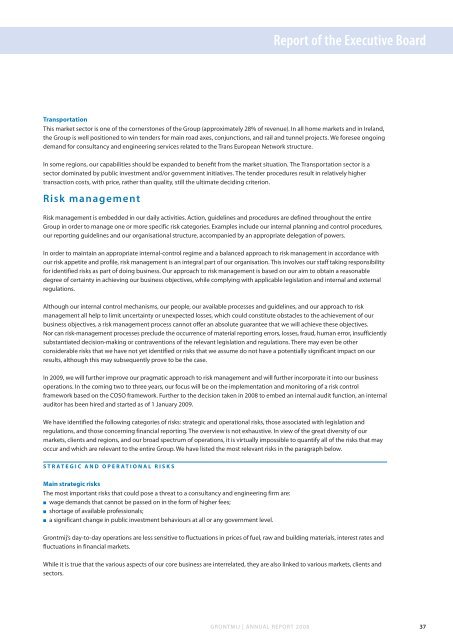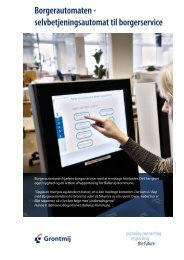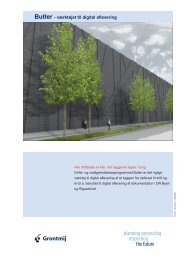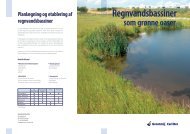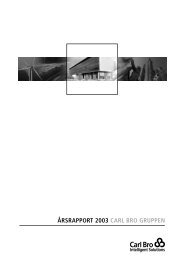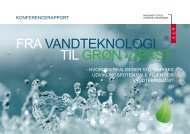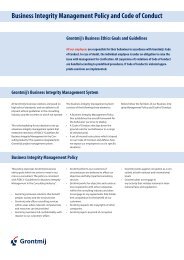Annual Report 2008 Sustainable design & engineering - Grontmij
Annual Report 2008 Sustainable design & engineering - Grontmij
Annual Report 2008 Sustainable design & engineering - Grontmij
You also want an ePaper? Increase the reach of your titles
YUMPU automatically turns print PDFs into web optimized ePapers that Google loves.
<strong>Report</strong> of the Executive Board<br />
Transportation<br />
This market sector is one of the cornerstones of the Group (approximately 28% of revenue). In all home markets and in Ireland,<br />
the Group is well positioned to win tenders for main road axes, conjunctions, and rail and tunnel projects. We foresee ongoing<br />
demand for consultancy and <strong>engineering</strong> services related to the Trans European Network structure.<br />
In some regions, our capabilities should be expanded to benefit from the market situation. The Transportation sector is a<br />
sector dominated by public investment and/or government initiatives. The tender procedures result in relatively higher<br />
transaction costs, with price, rather than quality, still the ultimate deciding criterion.<br />
Risk management<br />
Risk management is embedded in our daily activities. Action, guidelines and procedures are defined throughout the entire<br />
Group in order to manage one or more specific risk categories. Examples include our internal planning and control procedures,<br />
our reporting guidelines and our organisational structure, accompanied by an appropriate delegation of powers.<br />
In order to maintain an appropriate internal-control regime and a balanced approach to risk management in accordance with<br />
our risk appetite and profile, risk management is an integral part of our organisation. This involves our staff taking responsibility<br />
for identified risks as part of doing business. Our approach to risk management is based on our aim to obtain a reasonable<br />
degree of certainty in achieving our business objectives, while complying with applicable legislation and internal and external<br />
regulations.<br />
Although our internal control mechanisms, our people, our available processes and guidelines, and our approach to risk<br />
management all help to limit uncertainty or unexpected losses, which could constitute obstacles to the achievement of our<br />
business objectives, a risk management process cannot offer an absolute guarantee that we will achieve these objectives.<br />
Nor can risk-management processes preclude the occurrence of material reporting errors, losses, fraud, human error, insufficiently<br />
substantiated decision-making or contraventions of the relevant legislation and regulations. There may even be other<br />
considerable risks that we have not yet identified or risks that we assume do not have a potentially significant impact on our<br />
results, although this may subsequently prove to be the case.<br />
In 2009, we will further improve our pragmatic approach to risk management and will further incorporate it into our business<br />
operations. In the coming two to three years, our focus will be on the implementation and monitoring of a risk control<br />
framework based on the COSO framework. Further to the decision taken in <strong>2008</strong> to embed an internal audit function, an internal<br />
auditor has been hired and started as of 1 January 2009.<br />
We have identified the following categories of risks: strategic and operational risks, those associated with legislation and<br />
regulations, and those concerning financial reporting. The overview is not exhaustive. In view of the great diversity of our<br />
markets, clients and regions, and our broad spectrum of operations, it is virtually impossible to quantify all of the risks that may<br />
occur and which are relevant to the entire Group. We have listed the most relevant risks in the paragraph below.<br />
STRATEGIC AND OPERATIONAL RISKS<br />
Main strategic risks<br />
The most important risks that could pose a threat to a consultancy and <strong>engineering</strong> firm are:<br />
o wage demands that cannot be passed on in the form of higher fees;<br />
o shortage of available professionals;<br />
o a significant change in public investment behaviours at all or any government level.<br />
<strong>Grontmij</strong>’s day-to-day operations are less sensitive to fluctuations in prices of fuel, raw and building materials, interest rates and<br />
fluctuations in financial markets.<br />
While it is true that the various aspects of our core business are interrelated, they are also linked to various markets, clients and<br />
sectors.<br />
GRONTMIJ | ANNUAL REPORT <strong>2008</strong><br />
37


